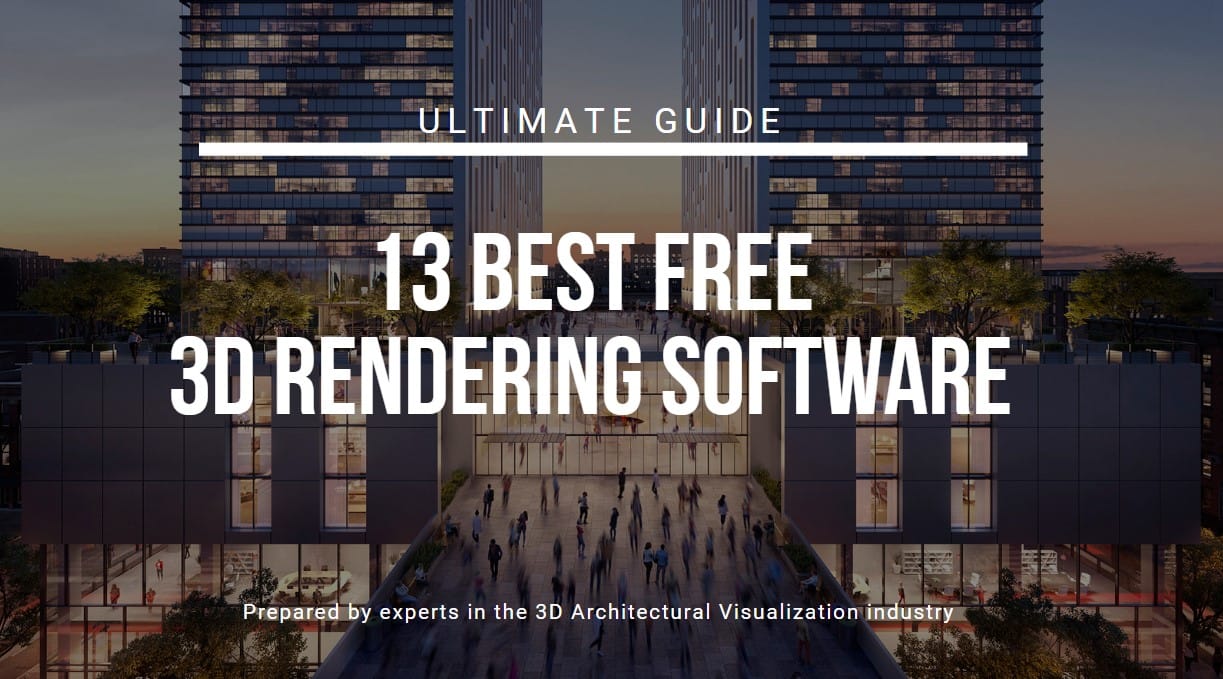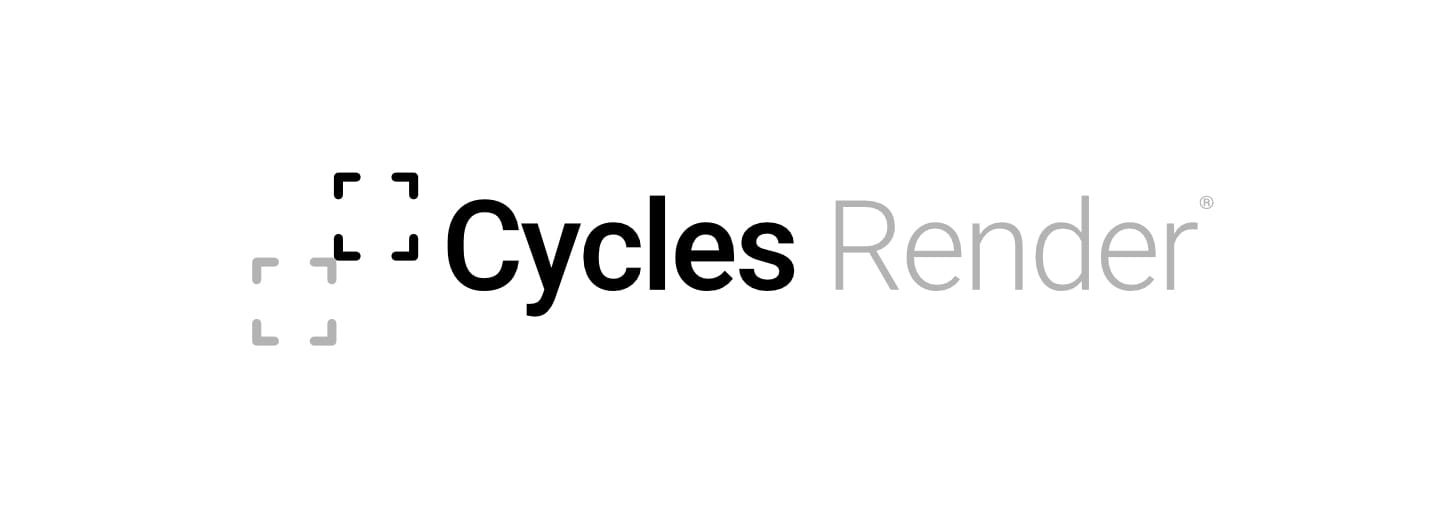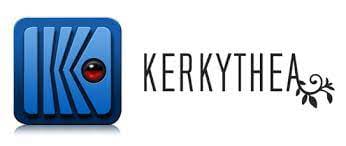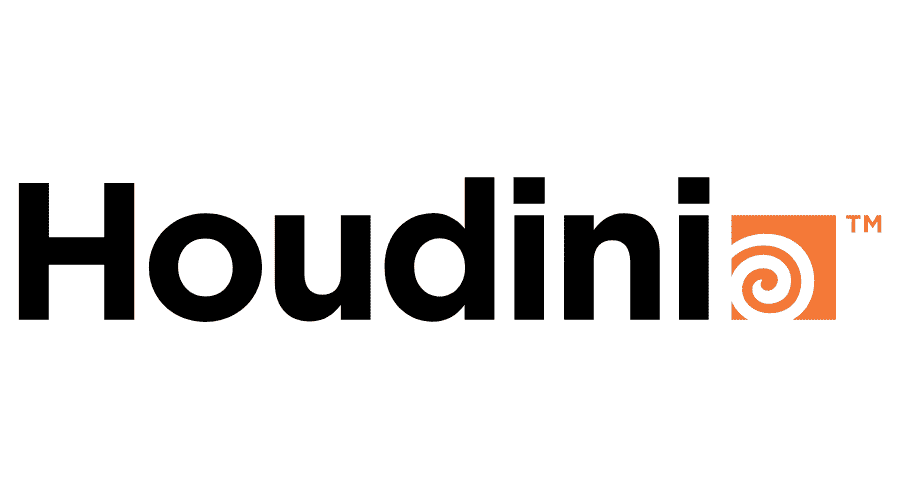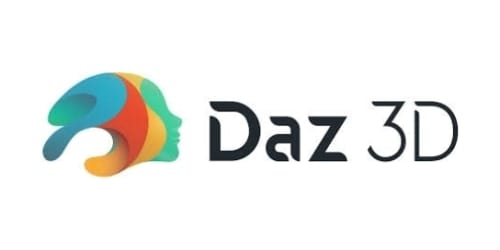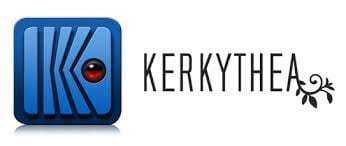13 Best Free 3D Rendering Software
Sounds simple but In truth, 3D rendering can be a difficult field to enter in without having a solid understanding of how 3D software works, and learning how to use these to create high quality content.
As a 3d studio with over a decade of experience, we’ve come across several rendering programs and compiled some of the best free ones you should consider within the visualization and 3D rendering software market, some of which are paid but in this guide we will take a close look at 13 best free rendering programs (trials included) so that the only investment is your time and dedication. You can also read about the best 3d rendering software for architecture in our blog, as these are also a solid option, especially if you’re looking to working professional with 3d rendering.
Before we proceed, let’s explain what 3D rendering programs are, so newbies can catch up.
What is 3D Rendering?
3D rendering is the process of creating images from 3D models that are made based on a particular design, which, in the field of architecture, are typically of buildings and interiors. These models are created before construction begins and can serve many different purposes. The whole process is carried out with the help of 3D rendering software, of which there are many types.
The images that are created this way can depict a design photo-realistically as all the 3D elements are covered by textures which imitate physical materials, and can also be illuminated as if it was a from the real world. 3D renderings can typically be split into two different categories – exterior renderings and interior renderings, but the same software can be used to create both of these.
In terms of quality, the final results depend a lot on personal skills of a 3D artist or 3D company that created the visual content, likewise the software plays a big role.
If you are interested to learn to learn exactly the 3D rendering process works then please take a look at our complete guide “Ultimate Guide To 3D Rendering & Architectural Visualization”.
1. Blender
Blender is one of the top pieces of free render software in the 3D design and graphic animation field. This powerful 3D creation suite is free and open-source and, as a result, has a fast growing community of animators, multimedia artists, tutors, students, scientists, and other professionals – that regularly update the software. The free public access further ensures Blender gets new features, bug fixes, and usability improvements faster than any traditional 3D design software.
The Blender program is intuitive and feature-rich. It supports all tasks in the 3D pipeline, everything from sculpting, visual effects, rigging, and virtual reality to simulation, 3D renderings, motion tracking, video editing, and 2D and 3D architectural animation.
With hundreds of tools, plugins, and other functionalities in its treasure trove, beginners may face a steep initial learning curve when mastering the software. However, the wealth of online educational resources for Blender makes this free rendering software far easier to understand than it might initially appear.
Pros
- Completely Free
- Supports the Entire 3D modeling and animation pipeline
- Gets regular software updates from the Blender community
- Multiple online learning resources
- Fast growing online community
- Comes with powerful renderers (Eevee and Cycles)
- Has an extensive system of add-on options
- Has quality animation, video editing, and other interactive 3D applications
- Impressive amount of pre-programmed keyboard shortcuts, which are a big time-saver
Cons
- It has a steep learning curve
- It does not specialize in any specific task, unlike some other specialized software in this article
- It is not an industry-standard tool
- Lack of external support (e.g., external renders) for certain aspects in its pipeline
- Cluttered menu panels and toolbars might overwhelm new learners
- The workflow and interface take a bit of time to learn and customize
2. Cycles Render
The Cycles program is a cutting-edge renderer that replaces native renderers in Blender (likewise in other paid 3D rendering programs like Poser or Rhino). Ever since, the path-tracing render engine has gained widespread acceptance among artists, studios, and the entire animation industry.
Like many Blender applications, Cycles is open source, highly interactive, heavily updated and maintained, and boasts an incredible range of rendering features. Some solutions include powerful subsurface-scattering, accurate PBR shading nodes, and vector displacement and adaptive subdivision solutions that enable Blender users to create realistic rendering with physically accurate illumination and calculations.
Pros
- Easy rendering program to learn
- Clean, interactive, and user-friendly interface
- Great for animation
- Comprises several impressive rendering features and, at the same time still easy to use
- Has tools such as support for caustics and cryptomatte and the powerful OIDN and OptiX denoisers.
- Creates highly photorealistic results and, as a result, is best for realistic rendering
- Has simple settings and workflow for easy, quick, and nice-looking renders
- Possesses Blender’s node-based materials system, which gives more freedom and tweaks than other rendering programs like Vray
- Contains the OptiX-powered rendering engine, which makes it an extremely fast path-tracer
- Lighting is calculated accurately in Cycles
Cons
- The Cycles program sacrifices render speed and viewpoint performance to prioritize realism.
- Noisy images when orbiting or navigating a scene
- Render times tend to be long
- The nodes contain many unnecessary options
- Light grouping is poor in Cycles
- Caustics is not as accurate in Cycles as in other render engines like V-Ray and Arnold
- GPU does not support volume rendering and subsurface scattering
- It is not industry-standard and is majorly used by hobbyists, freelancers, beginners, and small studios
3. LuxCoreRender
LuxCoreRender was initially released in 2008 under the name “LuxRender” as a completely free, physically based, unbiased 3D rendering engine. The name was changed to LuxCoreRender in 2017 during a project reboot which saw significant improvements in the rendering speed of the software.
LuxCoreRender is another renderer program on Blender like Cycles. Also, similar to Cycles, this add-on is open source which means you can customize all settings like the mood and light balance in scenes to suit your specific need.
As mentioned earlier, this free 3D rendering software uses the physically based rendering (PBR) model, which aims to render images in ways that replicate the flow of light just like the real world. The PBR system further ensures that LuxCoreRender is able to produce final results that look almost like a real photograph.
Pros
- Fast caustics and efficient synthesis of scenes with a large amount of light sources
- The PBR nature of the software gives final images a convincing photorealistic look
- The software can be tweaked for your particular purpose
- Support GPU rendering on Macs, unlike Cycles
- It is a standalone render software and can be integrated into several 3D programs, e.g., Blender, Max, Cinema 4d, Maya, 3ds Max, Sketchup, and many more.
Cons
- Like most open-source software, users have experienced issues with bugs.
- It is not industry-standard
- So many features to master make learning intimidating to new users.
- Export of scenes is slower compared to those of Cycles
- It lacks vital options for workflows such as character animation
4. Verge 3D
Verge3D is a real-time rendering toolkit for creating immersive and responsive 3D experiences on web browsers. The add-on is built to work on various services and software, including Blender, Maya, Modo, Autodesk 3ds Max, Microsoft Paint 3D, Marmoset Toolbag, Sketchfab, Facebook, and Microsoft Remix 3D.
It features the Puzzles option, a visual scripting environment that enables users without coding skills to easily design interactive scenes using the drag-and-drop approach. With Verge3D, you can build any number of engaging presentations for websites, portfolios, e-commerce stores, ads, AR/VR games, and e-learning content.
Pros
- Free for learning or evaluation purposes
- High-quality photo-quality images
- Supports different types of animation
- Optimized assets loading format
- Has the Puzzles editor that allows for no-code development
- Best interactive 3D web application for non-programmers
- Has seamless cross-platform interoperability
Cons
- For commercial projects, you need to pay for a license
- Designs will not go live without acquiring a license
- Certain operations (e.g., adding lens flare) cannot be done on the Puzzle editor and require coding knowledge
- Poor camera scaling
- Inefficient raycasting of skinned objects
5. Kerkythea
Kerkythea is a standalone rendering engine for converting 3D graphics into lifelike renders. As freeware, this 3D render software offers several interesting features such as ray tracing, metropolis light transport (MLT), realistic lighting, and physically accurate materials.
It can be integrated seamlessly into any software as long as it can export files in 3DS, OBJ, SIA (silo), and XML formats. Common software Kerkythea works with includes SketchUp, Blender, 3D Max, Wings3D, Silo, and Silo.
Pros
- Free to use for learning and commercial purposes
- Produces decent quality renders
- Robust, flexible, and e-learning tools.
- Accurate and excellent quality materials
- Compatible with the popular architectural software SketchUp
Cons
- Premium and more versatile alternatives like V-ray generate renders faster than Kerkythea
- Steep learning curve
- Too many tools, settings, shapes, textures, features, materials, environments, and techniques to master
- The interface is not appealing nor user-friendly
- Material adjustment slightly difficult to learn
- More compatible with some software (e.g., SketchUp and Max) than others
- Low rendering speed, especially in older models of computers.
6. Sweet Home 3D
Sweet Home 3D is an interior design software built to help architects, designers, and other users draw simple 2D house plans and view the result in 3-dimensions. Users can create houses of multiple floors with differentiated walls, rooms, doors, windows, sizes, and textures. Besides drawing the blueprints of a home, the software can be used to arrange furniture and home appliances within the interior and decorate the exterior as well.
This free render software is especially good for beginners as it has the drag-and-drop function that allows users to transfer home parts and objects quickly and easily from a catalog onto their plan. Also, there are options for users to view their 3D design in real-time even as they are editing the work. Lastly, for a free program, Sweet Home 3D produced an appreciable quality of photorealistic videos and images.
Pros
- Free, simple, on-premises, and cloud-based design solution
- The drag system makes it easy to quickly create 3D architectural scenes
- Easy to learn and use for beginners in the designing field
- It supports all versions of Windows
- Ability to print all views (2D and 3D) of your work
- Nice, Intuitive interface and detailed interactive prompts during designing
- Impressive language localization interface
- Each edit to the 2D plan results in an automatic update of the 3D view
- Availability of suitable help option
- Does not need a high-performing computer
- The paid version contains lots more home decorating objects and appliances
Cons
- Controls can be optimized much better
- Poor video rendering quality
- The less-than-satisfactory navigation system of the three-dimensional viewing window as objects users have difficulty moving smoothly on the window.
- Controls in software not sufficiently optimized
- Low graphic quality makes it impossible to use software for big, complex 3D modeling
- Dated and limited graphics and preset tools
- The appearance of images does not comply with professional standards
7. Houdini Apprentice
Houdini Apprentice is a 3D procedural application specifically designed to assist students, hobbyists, and learners create visual effects (abbreviated VFX) in films and video games. The software is the free demo version of the popular animation software, Houdini FX, and can only be used for learning purposes. It lets users produce 3D models and a variety of special effects, including simulation, complex reflections, particle systems, and other forms of 3D animations.
Due to the high cost of the powerful Houdini FX, the developers created this free version to allow interested designers to learn and try out the interesting features of the software for free before committing to buying the product.
Houdini Apprentice uses various methods such as texturing, modification of digital meshes, deformable geometry, and rapid animation of several layers of images to create its special effect. Moreover, these features give Houdini projects their amazing effects, which in turn makes the application popular among VFX companies like Sony Pictures and Walt Disney.
Pros
- The free version can be used for evaluation or learning purposes
- New users typically experience an initial learning curve
- Dozens of tutorials and free guides available for newbies
- Introduction of newer, updated modeling tools for easier poly modeling
- Massive updates to the surface shader system
- New viscous fluid shelf tools
- New tools like onion skinning and crowd ragdolls for better animation
Cons
- This version cannot be used for commercial projects
- The looping system takes some time to master
- Shifting from local variables to object attributes can create confusion for inexperienced users
- This version does not work with third-party rendering engines and saves scenes using its own file format
- Rendering is restricted to the resolution 1280×720
- Rendering files to formats other than hdanc, hipnc, picnc, and usdnc are word marked
8. Enscape (Trial)
Enscape is a 3D rendering software that offers a free 14 day trial, used for creating real-time rendering and virtual reality videos, images, and interactive apps. The plugin integrates into modeling software like SketchUp, Vectorworks, ArchiCAD, Revit, and Rhinoceros 3D and helps users turn their 3D models into realistic, immersive 3D experiences.
Enscape is majorly used by architecture firms and professionals in construction and engineering fields. The main strength of this application lies in producing realistic visualizations of scenes with minimal operating complexity. Further, it empowers design workflows by seamlessly integrating product/data visualization and design methods into one single process.
Pros
- Easy to create decent looking renders
- Does not need a large capacity pc
- Good compatibility with SketchUp
- Presence of ray tracing allows for accurate reflections and realism
- All changes can be reviewed immediately in real-time
- Low render times
- The fastest and easiest way to turn building models into beautiful, interactive walkthrough VR experiences
- Requires no previous specialized knowledge of programming to use.
- Users can design and visualize changes simultaneously in their design model on Enscape
Cons
- Is only free for 14 days, after which you will have to pay
- No options for doing 360˚ batch renderings and animations
- Low rendering quality
- It is difficult to determine exposure in 360˚ panoramic images
- It tends to create underexposed or overexposed images
- VRs on web browsers are laggy and have lower quality compared to offline renderings
- Textures break a lot as they cannot read relative paths
9. Daz 3D
Daz 3D is a media design application for creating 3D scenes and renders. It is a popular tool among illustrators and animators and can perform various tasks from 3D animation and rendering to figure posing. This free 3D rendering software combines different add-ons and graphic design platforms such as Daz Studio, Hexagon, and Genesis 8 to create rigged realistic human characters in 3D.
Pros
- Free render software
- User-friendly and highly customizable interface
- Has an advanced platform like Genesis, which can create unique scenes and characters
- The Genesis tool has morphing functionalities that can dress up characters and create body figures of different shapes, sizes, and muscularity
- Has the Hexagon application, which makes it easy for beginners to use the powerful features and capabilities of the Daz 3D platform
- Plenty of tutorials to learn about the creation of 3D images and animation
- Online forums and technical support available for users
- The 3-dimension software comes pre-installed with plenty of additional applications for users
- Software is compatible with the latest versions of Mac and Windows
Cons
- Posing controls of the animation tool difficult to control
- The installation process can be a little technical for new users
- Online discussion forum needs more helpful content for users
- Daz Studio does not work well on the UNIX partition of Mac OS X
10. Vectary (Starter)
Vectary is a 3D and AR/VR design platform for building and customizing immersive 3D designs with has a free version as well as a few paid plans. From the platform, designers can share or publish their WebVR or WebAR content to other websites. The site comprises crucial plugins (e.g., parametric plugins, mesh modeling, and subdivision modeling) that allows inexperienced users to build great 3D models from scratch. There are also tools for teams to collaborate on projects online and in real time.
Pros
- Free and easy to use for people without a 3D modeling background
- The platform has a very fluid and responsive design
- Several options for designing textures and surfaces that are not stock
- Does not require download as it is browser-based
- Operate on all operating systems
- Simple, visually appealing, and easy-to-learn UI and features
- 3D images can be printed
- Free video tutorials, how-to articles, email, forum, and online Live Chat support are available
Cons
- Users have to work online
- Documentation is very limited on how the various options on the platform work
- Modeling or smoothing out curved surfaces on meshes is hard to do with the available tools
- As a result, it is time-consuming and slightly challenging to design or make changes to objects with curved surfaces
- Weak knowledge base for online help and support
- Only allows up to 10 Projects on Free Version
- Works poorly on some browsers like Safari but has a better user experience on Firefox
- No suggestion on the best browsers to run the platform
11. Clarisse (Personal Learning Edition)

Clarisse is a 2D/3D rendering and animation toolkit designed to create renders, precompositions, and develop looks and appearance. The software works with CPU and specifically aims to simplify and improve the speed and power of complex creative workflows. The software offers a free version as well as a paid option.
The greatest strength of this free 3D render software lies in unifying lighting, rendering, immersive environments, and appearance development tools into a single, less complicated package. Clarisse works on Windows, Linux, and macOS and offers a comprehensive and flexible environment for creating CG projects.
Pros
- Intuitive and flexible settings and interface for modern designs
- Clarisse is a combination of a 3D rendering engine, an animation package, and a compositing software
- The engine is extremely fast compared to traditional renders
- Can quickly process datasets containing millions of polygons
- Great plugins for rendering and lighting
- The CPU-based engine and unidirectional path tracing enable users to work interactively on data-rich scenes, assets, and environments
- Textures are also created using the path-based system, which increases further increases the speed
Cons
- Some users think the UI is too simple for such a sophisticated tool
- The elements on the Clarisse software all have a similar hierarchical value which can confuse the design process
- Free Version doesn’t include access to all features
12. Guerilla Render

Guerilla is a rendering, lighting, and look development suite for CG, VFX, and hybrid projects. The software is commonly utilized in films due to its flexibility, ease of use, and high performance.
Also, the recently included procedural system, which can count four instantiation depth levels, adds more to the creativity of the application. An efficient system’s memory makes the UI easier to use, contributing to better light development and clean, sharp previews.
Pros
- Free uncapped usage (personal and commercial) for single users
- Easy to use and integrate into the user’s VFX pipeline
- PBR system contributes to the photorealistic rendering of stills and sequences
- Preecomp caching helps to eliminate render errors
- Documentation available for training
- Asynchronous OpenGL view on the software prevents the interface from freezing and also uploads the geometrics as the user work
Cons
- Highly flexible lighting system for outputting light into selected AOVs
- OpenEXR is available to support the compositing process by selecting objects and layers in the final rendering file
- Users will always have to work online
13. Wings 3D

Wings 3D is a free Dd rendering software created to model and add texture to low and mid-range polygon models in games and other animated films. It does not support animated GIFs and videos as the engine comes with only basic OpenGL rendering functionality. For this reason, the application is often combined with other specialized rendering applications like Blender for better rendering and animation.
Wings can be categorized as an advanced subdivision modeler and are compatible with the Windows, Linus, and Mac operating systems. The presence of texture mapping capabilities allows for more realistic graphics and designers can export documents in all standard file types.
Pros
- Completely free, fast, and cross-platform
- Easy to understand interface due to intuitive onscreen buttons
- Software is straightforward to use due to the drag-and-drop system
- Lack of program complexity makes it easy to work with the core controls for manipulating 3D functions
- It has nearly all the tools you’ll need for low-poly modeling
- It exports and imports files in almost all formats
- Sculpting capabilities that allow for better, more detailed models
- 3D Models print well
- The presence of a virtual mirror makes it easy to perform symmetrical modeling on the application
- On-screen texts provide descriptions of buttons during usage and make it easy to explore and recall various features of the software
Cons
- Wings does not support animation and rendering and need other advanced software to assist with that
- The menu comprises features like the spiral and torus knots which may be challenging for some printers to print
- Documentation is basic and sparse
- The software is not regularly updated
- The software might be slightly complicated for newbies
- Initial steep learning curve before getting a handle on features of the software
Conclusion
When it comes to the best free 3D rendering software, you’re spoilt for choice, and it can often be difficult to know which one to go for. The idea of this guide was to help give you a basic understanding of each type of software, their pros and cons, so that you can then go on to choose a few to test for yourself.
At the end of the day, there’s no one size fits all approach when it comes to free 3D render software, each software serves a different purpose, and may be better/worse suited to you depending on what your needs are as well your personal tastes and preferences.
If you’re new to 3D rendering, our personal recommendation is to try out a few of these free pieces of rendering software to see which one works best for you. If you’re already familiar with 3D rendering, and are looking for a career in architectural visualization, then consider also looking at paid options, as the most popular pieces of software used for commercial purposes usually require some kind of financial commitment.
Don’t forget to read about the best 3d rendering companies in our blog by following this link.
Further Reading
If you’re ready to dive deeper into 3D visualization, rendering workflows and real-estate media tools, these resources will help:
3D Rendering Resources — A comprehensive hub of articles on rendering techniques, case studies and industry insights.
Virtual Staging Guide — Learn how virtual staging can elevate your property listings, even before construction.
Ultimate Render Resolution Guide — Understand how pixel count, aspect ratio and format affect your render output.
CAD for Interior Design — Tips for interior designers working with CAD and preparing files for visualization.
Best 3D Rendering Software for Architecture — A comparison of professional rendering tools used by architects and studios.
Real-Estate Drone Photography Resources — How aerial visuals and 3D renderings combine to power listings.
3D Architectural Modeling Guide — A walkthrough of modeling processes that underpin great exterior and interior renders.
Ultimate Guide to Instagram for Architects — Leverage social media to showcase your renderings and build your brand.
Guide to Render Farms — Insight into distributed rendering services and how they speed up large-scale projects.
Author – Eddie, an experienced Sales & Marketing professional, joined NoTriangle in 2018 and has been an invaluable asset to the company’s growth. With his expertise in real estate marketing and as a communication specialist in the 3D Industry, Eddie has a keen interest in sharing his knowledge through writing, offering valuable insights and practical advice to readers.


